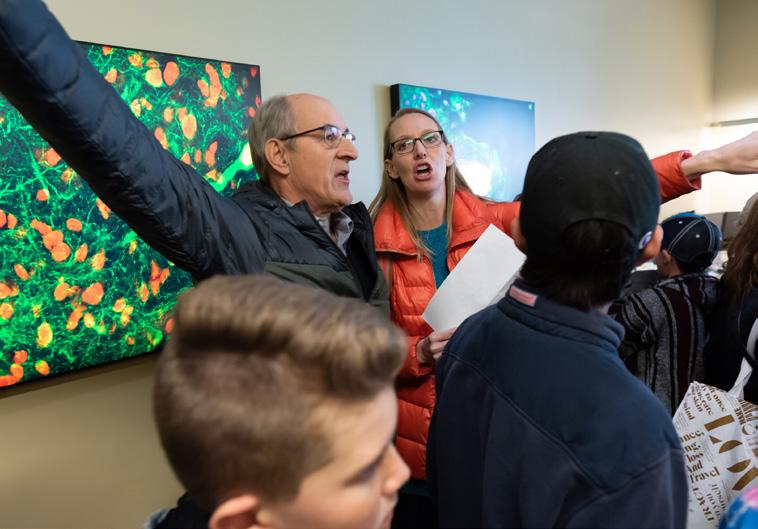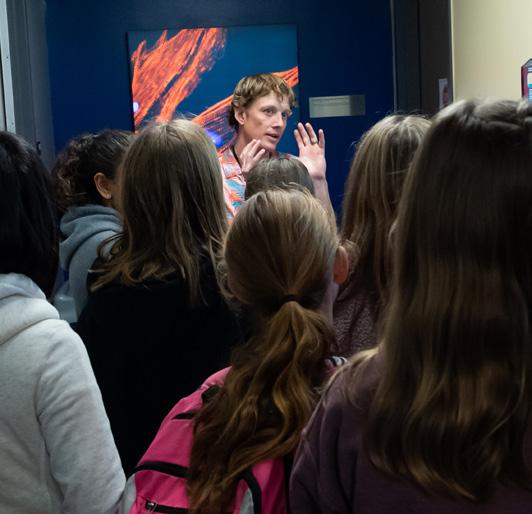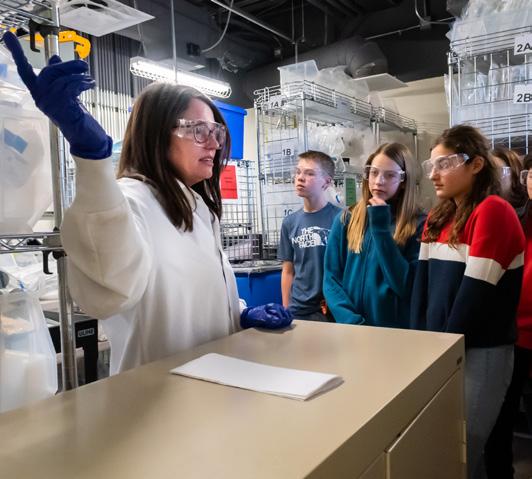
11 minute read
Gates Biomanufacturing Facility
SUCCEEDS BOUND BY SHARED GOALS
We’ve come a long way from a concrete slab and some equipment in 2015. A few entrepreneurial scientists were willing to jump in and build a facility, technology platforms, and a Phase I clinical trial Quality system that can launch clinical trials. This accomplishment is not trivial – biotech companies are hesitant to be the first customers in a new facility. Our ability to attract and retain clients is a tribute to the technical aptitude, hard work, and customer service our employees provide. Both the protein and cell therapy groups had multiple 4 a.m. mornings safely getting the therapies out of the door in those early days. It’s great to see that we are now producing four-to-six products monthly with a fully trained staff of 50. The Gates Biomanufacturing Facility (GBF) staff deserve a tremendous amount of credit for all this and for achieving its five-year vision of translating life-saving University of Colorado technologies into clinical trials – all during a world-wide pandemic. ~Gates Biomanufacturing Facility Executive Director Matt Seefeldt, Ph.D.
Determination is in the filtered air at the GBF. Also, the smell of pride and sterile Isopropanol are noticeable everywhere.
Over the past year, the GBF team continued its life-saving work despite many challenges brought on by the COVID-19 pandemic. In January 2020, there wasn’t a conference room available anywhere in the building – nor an idle moment. The GBF was supporting manufacturing for ongoing Phase I clinical trials and developing new processes rapidly. Straight ahead was the direction, and full throttle was the speed. As the pandemic took hold in March, however, many project plans were upended and any sense of normalcy disrupted. Driven by duty, the urgency of the need, and scientific curiosity, GBF team members pressed forward and progress didn’t miss a beat. Deemed essential workers, the GBF team continued to work on-site with proactive leadership and the finest HVAC system around, refusing to cede hard-won momentum to the virus.
It was a year of growth and change for the GBF, as the facility significantly expanded its footprint from 14,000 to 20,000 square feet in Bioscience 1 across the street from campus. The facility also expanded its headcount to 50 members despite a difficult hiring environment, and these new professionals provided fresh perspectives and abundant talent. In 2020, the GBF was further reorganized to move under the direction of the CU Anschutz Chancellor rather than the School of Medicine. This change in direction was important in providing more operational flexibility and greater coordination between the GBF and partner organizations on the CU Anschutz campus. Additionally, Matt Seefeldt, Ph.D., who joined the GBF management team in 2014 prior to the facility’s opening in 2015, was elevated to Executive Director, and Charles Hickey MBA, was brought on as the new Director of Finance and Administration (see page 62).
Despite unprecedented pandemic challenges throughout the year, GBF leadership was able to grow the influence of the organization in multiple dimensions (and keep everyone

Former Gates Center CFO Tim Gardner (on left) helps direct Colorado Academy students during their educational visit to the Gates Biomanufacturing Facility in January 2020. We said farewell to Tim Gardner and want to thank him for his many contributions since 2013 to the growth of the Center and Gates Biomanufacturing Facility. Felicia Mast and Graciela Gamez take steps to harvest the first UCD19 patient’s cells for a University of Colorado clinical trial on July 30, 2020. A milestone day!

Dear Gates Center and Gates Biomanufacturing team, I feel like I’ve been held in a state of awe and wonder following the announcement of the first cell-based therapy, UCD19 CAR-T cells, produced at the Charles C. Gates Center for Regenerative Medicine. It is thrilling and slightly hysterical to think back on those early days, just over five years ago, as we huddled around Joy Mathew’s living room framing a business plan on oversized post-it notes; when we gathered in obscure conference rooms with engineers and regulatory experts trying to sort through a maelstrom of safety protocols (many of which were still being formulated by the self-proclaimed expert regulators in ivory towers) as we hunted around campus for a suitable building to renovate, or a plot of land to claim and build; and when we sat in quiet wonder as Dr. Roop and his colleagues across the Anschutz Medical Campus...and around the world!...sketched out a vision for cures in our lifetime! As a lay person who had the honor of playing a very minor role in communicating our collective vision with influencers who could help bring it to fruition, my heart always ached with hope for early results, but a prudent mind governed those expectations toward an unforeseeable future. Witnessing the transference of the benchtop vision to bedside cure is nothing short of miraculous. Tutti Bravissimi to the giants, visionaries and courageous patients involved in making this dream come true. Here’s to years of miracles in the making! ~With deep gratitude and fondness, Former Gates Center Executive Director Patrick Gaines
testing negative). GBF management faced supply chain disruptions and increased uncertainty. In response, GBF teams immediately retooled and adapted. Whether working on-site or at their kitchen tables, team members supported the delivery of protein-based and cell-based therapies without interruption, including the successful launch of the UCD19 trial that has resulted in patients seeing complete remission for difficult-to-treat B-cell based malignancies. The GBF made this switch with zero lag-time, already poised to embrace the model of remote work. Such agility was made possible by a diverse team of individuals, pooling their collective drives to succeed, passions for helping people, and boundless scientific talents. Here’s a quick tour of GBF teams, what makes them great, and how they complement each other:
Protein and Biologic Chemistry (PRO):
Headed by Associate Director Gana Batt, Ph.D., the Protein Chemistry group boasts keen eyes, sharp wits, strong backs, and many advanced degrees. Undaunted, they face fresh challenges regularly in the scale-up and optimization of processes, as well as in the scratch development of new processes as needed. During Phase I manufacturing, clients may not fully appreciate the challenges of scale-up and process development, but Dr. Batt certainly does.
Currently PRO is developing several novel therapies in conjunction with University of Colorado under Good Laboratory Practices (GLP): the first for the treatment of Epidermolysis bullosa (EB), a life- threatening genetic skin condition; the second to ameliorate oral mucositis, a painful and nutrition-compromising side effect of head and neck radiation used for cancer treatment; and the third, a unique treatment paradigm using stem cells and gene therapy strategies to promote healing and tissue regeneration in multiple tissues.

Cellular Therapy (CT):
Cellular Therapy is a high-pressure environment. The demands are great in time, space and materials. Formally under the interim direction of Matt Seefeldt Ph.D., CT and the complex processes involved require great dedication. Such processes may begin with the blood of a patient/donor and then undergo genetic modification to recognize and fight cancers once considered uncurable. Each process is a unique endeavor – and a beacon of hope for patients who have exhausted all other therapies. Whereas PRO starts with something dirty (bacterially expressed proteins) and ends with something clean (drug substance), CT starts with something clean (a patient’s own blood) and ends with something clean (final product for infusion). In 2020, CT manufactured cell therapies for the University of Colorado’s UCD19 CAR-T trial for adult patients with relapsed and refractory B cell lymphomas, and was well underway planning for a second UCD19 CAR-T trial for children and young adults with resistant acute lymphoblastic leukemia in early 2021. The team was also working on a third trial scheduled to open in mid-2021 – a CD19x22 bicistronic CAR-T therapy that recognizes two separate targets on the malignant B lymphocytes of patients with relapsed/refractory leukemias and lymphomas.
As an emerging leader of CT, Felicia Mast M.S., sums it up this way: “The most critical aspect of our work is ensuring
GBF Executive Director Matt Seefeldt shares the complex processes involved with cellular therapy with Colorado Academy students.
we manufacture a consistent, safe, and high-quality product for every single patient. The starting material for our manufacturing process comes directly from the patient’s blood, and just as each individual is unique, each patient’s cells are unique and can behave in unpredictable ways. The CT team must keep up with this unpredictable behavior because the cells do not take a break – once manufacturing has begun, it is a continuous process until we can get them back to the patient or in the storage freezer. In addition to accounting for unpredictable scheduling and cell growth, it is imperative that the cells are maintained in a sterile environment free from any contamination because they will be infused back into cancer patients with delicate immune systems. The CT operators must be highly skilled and trained not only on how to culture the patient’s cells so they are better able to recognize and kill cancer, but also to prevent contamination of the patient’s growing cells through the use of aseptic technique, gowning, and cleaning. Every step of the manufacturing process is carried out with dedication and care for each patient.”
Matt Seefeldt, the GBF’s new Executive Director, is a priceless asset. Matt is among the best industrial biochemists I’ve ever worked with and has proven his ability to translate mouse models into cell therapies. There are only a couple of places where people can go with early-stage regenerative medicine discoveries and produce drugs from them that work, and thanks to Matt, the Gates Biomanufacturing Facility is one of them. ~Kyle Lefkoff, Founder and General Partner of Boulder Ventures Ltd.
The QC team may be the over-thinkers of the bunch, keeping a laser focus on product safety. Team QA provides oversight and supports regulatory compliance. QC/QA act in close collaboration with the other departments to test and release products, as well as to conduct internal investigations and scientific studies relevant to clinical manufacturing. Led by Associate Director of Quality Assurance, Chandresh Undhad M.S., the Quality team has decades of combined experience testing and releasing manufactured products for human use, in both commercial pharmaceutical and investigational settings.
Supply Chain and Project Management (SCPM):
Headed by Director Terri Foote, this department has revolutionized both the flow of materials through the GBF and the flow of people and activities on a daily basis. Implementation of the Great Plains supply chain management system across the GBF for materials ordering and inventory tracking was a momentous achievement and removed major stumbling blocks and obstacles to growth. Additionally, project management tools were applied directly to all the GBF operations, enabling improved efficiency, dynamic forward-looking scheduling, and better
GBF’s Supply Chain Planner, Denise Feasel, explains to Middle School student visitors, the importance of supplying high quality materials in a clean and timely manner to be used in producing and testing our products. relationship management with clients. Project Manager Jordan Krause, M.S., describes the pathway to sustainability for the GBF: “The success of our cell therapy and protein chemistry campaigns at the GBF relies not only on sharp technical skill and quality oversight, but also in efficient and adaptable facility-wide systems that keep projects on track and resources flowing. When the GBF operations began in 2015, we were a small group of scientists focused on developing our technical platforms, with clinical manufacturing merely an aspiration for the future. We have since grown in both staff size and vision. Today at the GBF, with full development and manufacturing schedules, SCPM is a dynamic team that drives routine activities and reacts quickly and effectively to unforeseen issues, keeping our facility focused on treating patients through translational research and manufacturing.”

Proactive leadership is a big part of what makes GBF successful. Not top-down leadership, but more a distributed system based on shared goals and a sense of discovery among colleagues. Even with the challenges of 2020 and turnover at the director level, team members kept all projects moving forward. All stakeholders, including the Anschutz Medical Campus, valued hospital partners, external clients, and GBF staff, benefit from this collaborative environment, where subject matter experts are always consulted, and valuable information is shared broadly. With the great diversity of backgrounds of GBF staff, expertise and ideas have currency at the GBF. The long list of clinical ailments begging for solutions provides future challenges driving the GBF mission today and fuels staff pride and satisfaction. Unaccustomed to failure, GBF teams and leadership made 2020 one of the most productive years yet, through a collaborative work environment and sheer determination. Due to the promise and prominence of their work, GBF team members will be instrumental to the translation of life-saving therapies at the AMC, from the benchtop to the bedside, for many years to come. With the whole campus cheering them on, the GBF is a strategic asset in the delivery of 21st century cures. The sense of pride and smell of sterile Isopropanol are still noticeable throughout the facility.










